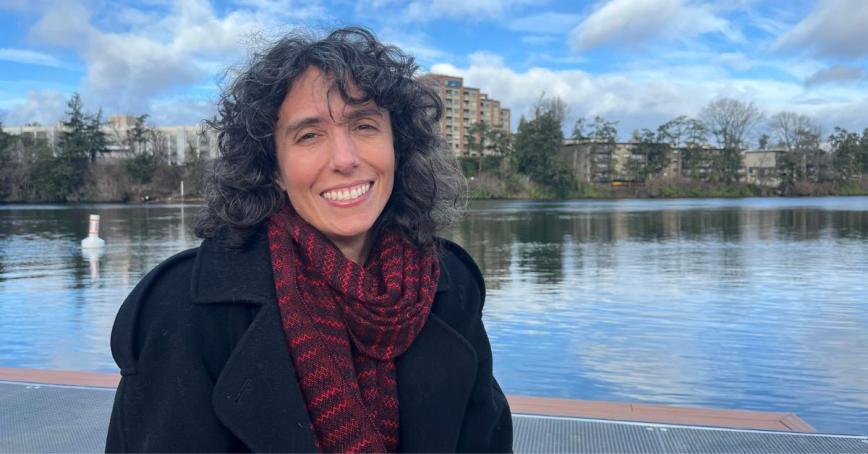Place names, narratives and mapping reconciliation
Topics
Featured
Share online

Learn more about the Master of Arts in Tourism Management program.
What if, instead of standing in James Bay, downtown Victoria, you understood you were in Whosaykum, known as “the place of the mud” in lək̓ʷəŋən language? The mud is gone—not through the natural passage of time, but because it was filled in to make way for the Empress Hotel.
How does the place name Whosaykum change how you think about James Bay? This is a question driving Melinda Quintero’s research. Quintero, a settler and student in the Master of Arts in Tourism Management program at Royal Roads University, is uncovering the stories that Indigenous place names tell about the lands we inhabit—focusing on the shoreline from Cadboro Bay to Millstream in Greater Victoria.
“Tourism has this unique ability to tell stories,” Quintero says. “But the stories we’ve told in the past have often excluded Indigenous voices. Place names are a way to amplify those voices.”
Her thesis explores the power of Indigenous place names to spark meaningful truth and reconciliation within the tourism industry. By mapping lək̓ʷəŋən names onto Victoria’s landmarks, Quintero aims to challenge the colonial narratives that shape many local tourism experiences.
The idea for her project emerged during her studies at Royal Roads when she was inspired by a dynamic map of Salt Spring Island that incorporates Indigenous place names and stories. “I saw that map and thought, there must be one of these for the Victoria area,” said Quintero. Upon further investigation, she found no Victoria equivalent.
“Tourism has this unique ability to tell stories. But the stories we’ve told in the past have often excluded Indigenous voices. Place names are a way to amplify those voices.”
Her work weaves together academic scholarship, archival records, and public resources into a rich database that can be integrated into maps of Victoria.
“The way these names connect people to the land is incredibly powerful,” Quintero explained. “It’s not just about data points in a spreadsheet—it’s about understanding the responsibility that comes with a collection like this.” Quintero has pulled together 99 names— “and the list is still growing” she says.
Quintero is also mindful of her responsibilities as a settler researcher. Guided by conversations with her thesis committee member Dr. Shauneen Pete, Chair of the Emerging Indigenous Scholars Circle at Royal Roads, she has focused on ethical approaches to her work.
“This is about something much larger than just making a pretty map,” Quintero said. “It’s about demonstrating what’s possible while respecting Indigenous communities’ autonomy over their histories, languages and data.”
A significant feature of her work is consultation with Indigenous scholars and First Nations. Quintero and Pete have been working together to carefully and respectfully build these local connections.
Quintero’s research defers to the many Indigenous scholars and academics in the region who are documenting their languages through connections to their own Knowledge Keepers and language speakers. To compliment this Indigenous research, as a settler, Quintero relies on publicly available sources, such as monuments, Indigenous websites, and academic publications.
“This project gathers what’s already in the public sphere, showing settlers how much is out there,” she explained. “It’s about reciprocity—building awareness of what already exists in the settler landscape to encourage respect and awareness for Indigenous history and language.”
As her research evolved, what began as a project to document monuments for tourists quickly uncovered a troubling history of erasure.
“I thought I was just going to go around and write down where the monuments were and what they commemorate,” she said. “But then I started reading these signs that flippantly refer to the destruction of sacred Indigenous sites or the resettlement of people and villages to make way for colonial development, and I realized: this is a map of colonization. And then you learn about desecrated burial sites in Esquimalt and grave robbing in Uplands, and you see that putting Indigenous language on a map could have serious impacts on truth and reconciliation.”
“Colonialism would have us believe these cultures and languages are broken, gone. But they’re not. They’re still there. The continuity of culture and language persists, and that’s been super educational for me to shift away from my ingrained colonial perspective,” she said.
Quintero’s work contributes to broader conversations about advocacy and reconciliation. “We have PKOLS, the SENĆOŦEN name for Mount Douglas since time immemorial. Indigenous advocacy brought back that name. It’s there on the mountain, on certain maps and is growing in use in the settler community, but it’s still not in the Canadian government’s geographical names database,” she said. “The Indigenous and settler communities came together to push for those changes and there is more work to do.”
Through her research, Quintero demonstrates that tourism can be more than sightseeing—it can be a bridge to understanding. “It’s about connection,” Quintero said. “When you understand the names, you begin to understand the stories. And that changes how you see the world.”
Quintero will showcase her thesis at the 2025 Conference on Communication Ethics this February. Learn more and register for the event here.